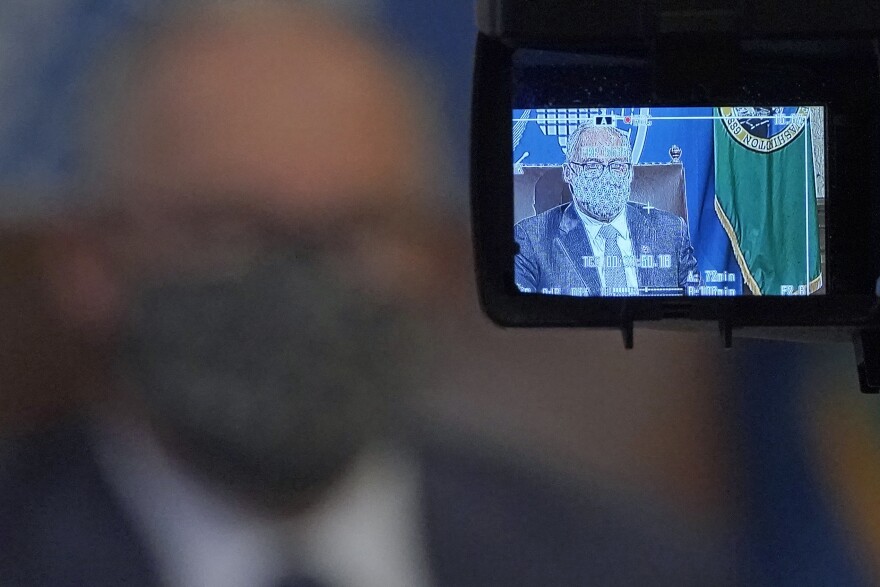COVID-19 is now so entrenched in daily life that some may not have noticed how it's bled onto the screen. From subtle mask wearing to celebrations of essential workers, the coronavirus pandemic has made its way into commercials and entertainment alike—sending different messages along the way.
If you turned your TV on in March, as states started shutting down businesses and asked people to stay home, you likely heard some variation of this:
Messages of community and strength were rampant back then, when the scope of the virus' impact was still unknown. Illinois State University media professor Lauren Bratslavsky said that has evolved over time.
"In the first month or so, commercials were all like that--very rah rah support of first responders. And we're gonna push through this without kind of knowing how long the pandemic would be," she said.
More recently, those messages have become somewhat less on the nose. Face coverings and social distancing often is seen on screen, normalized in the same way they've become in real life.
Take, for example, a pizza delivery person dropping off food in a branded Domino's mask.
Bratslavsky said this isn't by accident--it's a method of inspiring confidence in consumers that they can still buy things and it will be safe.
It's also a way to try to prove corporate responsibility. Bratslavsky gives this hypothetical:
“Say if Amazon warehouses are having like an outbreak of COVID, then you have an ad from Amazon, showing the workers at the warehouses wearing masks as part of this inspirational message about, you know, what they're doing to protect people," she said.
Amazon, in fact, did have an ad campaign in March celebrating their employees for working through the pandemic. But the company later reported in October that nearly 20,000 front-line workers tested positive.
A more recent Amazon ad portrays a young dancer who overcomes challenges to perform. It's tagline: "The show must go on."
Bratslavsky said, for any company, this can be a form of damage control.
"Whether or not maybe that company has a track record or not of treating employees well, at least in their advertising, they show how they're taking care of their employees," she said. "That's one way to spin that kind of a message.”
Bratslavsky said these "corporate responsibility" signals aren't likely to rock the boat—especially if the companies are still trying to appeal to a broad audience. She said the message you're most likely to see is, "Wear a mask."
But messages that undermine health guidance can be more subtle, she said.
"Often, in any sort of media analysis, what is not there is as important as what is there," she said. "If we have a lot of ads, for example, that would feature people wearing masks, and there's an ad where there is a person not wearing a mask and it's a situation where it's pretty evident that a person could be or ought to be wearing a mask, then that does seem like a sort of way of going against that grain," she said.
Where there's more latitude to make a splash, she said, is in entertainment.
Late night television has seen more changes than nearly any other genre—with the exception, perhaps, of reality TV.
Hosts are taping from home or sitting alone in an audience-free studio. But that hasn't stopped them from riffing on the mayhem.
Trevor Noah, for example, opened his show after President Trump contracted COVID-19 this way:
"As a comedian, I'm not gonna lie, my first instinct was to make jokes. Jokes about how a 74-year-old man who doesn't eat vegetables and eats way too much meat is literally the kind of guy that corona puts in its dating profile."
Noah's punchline is less comedic and more honest: if the president of the United States got this virus, despite all of the resources at his disposal, what excuse does anyone else have to not where a mask?
Other comedy shows have latched on, as well. Last month, South Park hosted an entire coronavirus special that scored the series its highest ratings in seven years.
The episode's running joke was chin diapers. That's what its writers named the phenomenon of wearing a mask down around your chin instead of covering your mouth.
Bratslavsky said the animated nature of the show makes the commentary less cringey than seeing real people breaking health guidance. She noted the anxiety many people say they feel when they see a party or concert crowd on screen during COVID times, even if it's old footage.
"There's definitely differences, I think, in what a cartoon can do versus a TV show can do or live action can do," she says. "On the live action side of it...Are they replicating our kind of fatigued, zoomed-out lives that we have? Or kind of more what we might experience in our home bubbles?"
Some shows have opted to incorporate COVID into their storylines and means of production. Shows like NBC's "Connecting" and Netflix's "Social Distance" use a Zoom-style format. Some court dramas have featured remote hearings, much like real life. The latest season of the Great British Baking Show emphasized that contestants agreed to quarantine together for the show's season.
Bratslavsky said their is nothing to really compare the impact of COVID-19 has on media. She said retrospectively, media scholars will look back at COVID-19's presence in pop culture, examining where and when these themes arose, what the context of production was, and what the audiences they served were worried about at the time.
There's no subscription fee to listen or read our stories. Everyone can access this essential public service thanks to community support. Donate now, and help fund your public media.


